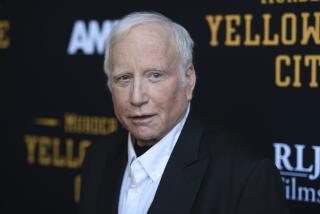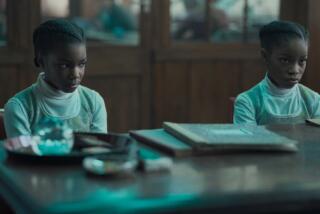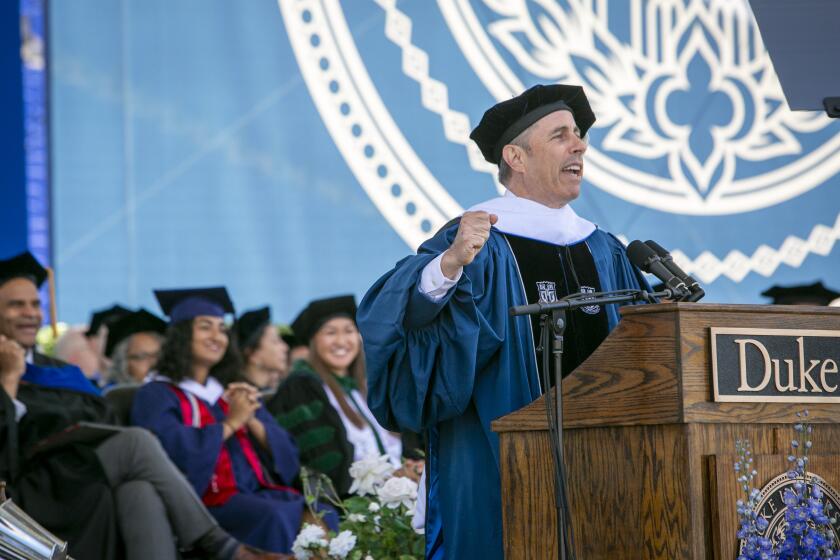Making a Bad Guy Grin : Cinema: The public hounds Orange’s Pierce Lyden, king of the black hats in B Westerns, at the Sierra Film Festival in Lone Pine, setting of many horse operas.
The ceremony celebrating 70 years of filmmaking in the rugged Alabama Hills completed, the white-haired gentleman in the black cowboy hat and fancy Western duds tramped over the sagebrush-dotted landscape to have his picture taken.
“That was quite a thing,” said former B-Western movie badman Pierce Lyden of Orange, a featured guest at the first Sierra Film Festival, held last weekend in this tiny town in the shadow of Mt. Whitney on the eastern side of the Sierra.
“Yeah,” mused Lyden, 82, “I saw a lot of the old fellas today.”
During the Sunday afternoon ceremony, Lyden’s old friend, Roy Rogers--the festival’s guest of honor--dedicated a plaque commemorating Lone Pine’s role as one of Hollywood’s favorite locations since 1920.
For at least four decades, the sound of gunfire and hoofbeats regularly echoed through the Alabama Hills, as the heroic likes of Rogers, Tom Mix, Buck Jones, Hopalong Cassidy, Gene Autry and John Wayne galloped through the area’s picturesque rocks and boulders.
And Lyden, one of the baddest Black Hats in B Westerns, spent many days in the Alabama Hills squaring off with Roy, Hoppy and Hollywood’s other legendary White Hats.
“We were all over this place, but I worked mostly in the ‘Bama rocks,” recalled Lyden, squinting into the afternoon sun as he surveyed the huge boulders in the distance, where he took more than a few tumbles for the cameras.
As Lyden says: “I think I’ve got my name on every one of the rocks. It’s painful to look at some of them.”
The retired actor, looking spiffy in his pearl-buttoned Western shirt with its silver-tipped collar, was interrupted by a young woman asking him to autograph her book on Western movies.
A smile danced across the movie badman’s craggy face.
“Where do you want me to sign?” he said.
A chance to bag an autograph from one of the guest celebrities who worked on Westerns filmed in Lone Pine was just one of the draws of the Sierra Film Festival, which attracted more than 2,000 visitors.
During a Sunday morning panel discussion, fans were treated to firsthand filmmaking memories. Participants included Lyden, stuntman-turned-actor Richard Farnsworth (“The Grey Fox”), singing cowboy Eddie Dean, Rand Brooks (“Lucky” in the Hopalong Cassidy series), stuntman Joe Yrigoyen (Roy Rogers’ stunt double), movie bad guy Terry Frost, stuntman Jack Williams, former Rogers leading lady Linda Hayes and Rogers’ director, William Whitney.
The two-day event, co-sponsored by the California Arts Council and the Inyo Council for the Arts, also featured stunt shows in the Alabama Hills and screenings in the high school auditorium. The Saturday night showing of the classic “Gunga Din,” perhaps the most famous film shot in Lone Pine, was a sellout.
Recalled Farnsworth, who earned $7 a day as an extra on “Gunga Din”: “I didn’t realize there was that much action in that until I saw the film last night.”
During the Sunday afternoon plaque dedication, Rogers recalled making his first starring feature, 1938’s “Under Western Stars,” in Lone Pine. “It was,” he said, “the most impressive time in my life.”
The King of the Cowboys, who will be 79 in November but looks at least a decade younger, seemed sincerely touched by the large turnout of fans and old movie-making colleagues. He summed up his feelings by singing--and yodeling--a song he recently wrote for his new album: “I Feel Like I’ve Grown Up With Everybody That’s Alive and Kickin’ Today.”
“I’m still alive and kicking today too,” Rogers told the crowd.
For Western fans, however, the big draw of the festival was a chance to take a guided bus tour into the Alabama Hills, a place where movie history has been played out at almost every turn.
Between the time silent movie comedian Fatty Arbuckle filmed “The Round Up” in 1920 to the recent science-fiction thriller “Tremors” with Kevin Bacon, more than 200 features and serials--and dozens of TV Westerns and commercials--have been shot in Lone Pine.
To aid film buffs, special photo markers were set up along Movie Road, a narrow dirt road that winds through the area of the Alabama Hills dubbed Movie Flats.
Fans, for example, could look at a production still from “Charge of the Light Brigade” and see exactly where Errol Flynn halted his British army patrol.
Or they could see the large boulder that Hopalong Cassidy and his sidekick California used to hide from the bad guys in “Silent Conflict” in 1947; three years later Gene Autry and Pat Buttram hid behind the same boulder in “Beyond the Purple Hills.”
Film historian Dave Holland of Granada Hills, who was historical consultant for the festival, said the appeal of Lone Pine’s Alabama Hills to movie-makers is obvious.
“There’s just no place in the world like it,” said Holland, whose new book, “On Location in Lone Pine,” chronicles the area’s film history. “You have the stark desert rocks out there and the snow-capped mountains in the background. You can’t beat that.”
Festival coordinator Kerry Powell came up with the idea to hold a film festival in Lone Pine.
As a child growing up in the ‘30s, Powell recalled, she saw some of the sets for “Gunga Din.”
“I don’t remember the filming, but I remember seeing elephants up there and how exciting it was seeing elephants in our hills,” she said. “And I did get to see Hopalong Cassidy filming over on the Anchor Ranch.”
For years, Powell said, she thought that a permanent marker should be erected in the Alabama Hills, “so people would realize what happened there. It’s really a big chunk of Hollywood history.”
Orange’s Lyden, who has fond memories of working in Lone Pine, is no stranger to Western film festivals. He and his wife, Hazel, attend two or three different U.S. festivals each year.
“It’s quite a shot in the arm for an old boy like me to be remembered,” he said Saturday while staffing a table in the exhibit hall.
Lyden was selling copies of his four self-published books chronicling his days “riding the reel range.” He also offered red T-shirts (“Stick ‘Em Up!!!”) and mugs inscribed, “The Movie Bad Man--Pierce Lyden.”
During his heyday playing Western bad guys, Lyden said, people on the street would often say, “I know your face, but I don’t know your name.”
That’s changed today, thanks to the film festivals.
“People know my name now,” he said, his hands stuck in the pockets of his fancy Western pants. “I get fan mail now, which I never did when I worked. Nobody ever sends fan mail to the villains.”
In fact, people who watched him in the ‘30s and ‘40s as kids come up to him today and say they would hiss and boo, throw spit wads and fire their cap pistols at the screen whenever he and his badmen cronies came on screen.
“Roy Rogers would beat the devil out of me or something, and that was a big laugh for them,” he said with a grin.
Lyden, who was voted Villain of the Year in a 1944 movie fan poll, retired from films in 1962. He spends his time writing free-lance articles about his days working in more than 400 films, movie serials and TV shows. And he’s thinking about writing a fifth volume of his movie memoirs, this time on the serials.
“It keeps me busy, and at my age you’ve gotta do something. You can’t sit in that rocking chair,” he said as a fan approached him for an autograph.
Lyden shot another B Western badman grin.
“Howya doin’?” he asked.
More to Read
Only good movies
Get the Indie Focus newsletter, Mark Olsen's weekly guide to the world of cinema.
You may occasionally receive promotional content from the Los Angeles Times.






